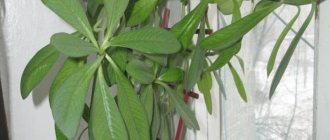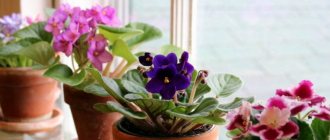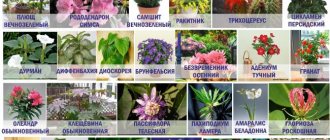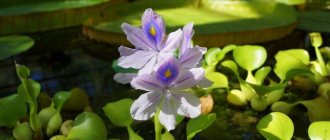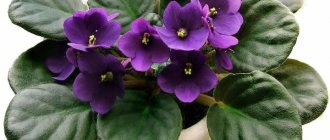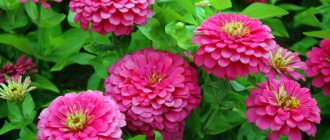Since ancient times, indoor plants have been a decoration for the home and a delight for the eyes. By growing this or that flower in his home, a person is confident that his new “green friend” will have a positive impact on him and his life.
However, indoor plants, like all living things on our planet, have their own energy. Our ancestors noticed that when one or another flower appears in the house, both positive and negative changes can occur to the owner. This is where the division of indoor plants into those that bring prosperity into the house and those that bring misfortune with them came from. In our age of technological development, people continue to listen to ancient fairy tales and legends when deciding which home plant will help them.
Cyperus
It is believed that Cyperus has very strong energy that suppresses the human biofield.
The plant negatively affects the health of residents. Anyone who keeps Cyperus in his room usually gets sick a lot and often.
To date, there is no scientific evidence that the plant can cause illness in humans, but people continue to be afraid to have a flower in their home.
Beliefs
Beliefs that are dedicated to house flowers have been formed over the centuries. This was facilitated by events that happened to different people. Descriptions of these cases were passed down from ancestors to descendants.
When choosing home flowers, you should not rely on superstitions, but be guided by your personal feelings. Many plants are dangerous for completely everyday reasons:
- poisonous sap or leaves;
- allergens;
- thorns.
By the way, superstitions have formed mainly about popular plants. For example, there are no negative or positive rumors about orchids because they have only recently become widespread.
Mostly beliefs are associated with the withering of plants. For example, a dead flower means that it took away grief from its owner. Most people know that stolen plants take root better. But few people thought that the flower could die if the cuttings were separated incorrectly.
Monstera
Monstera is a plant with carved leaves. In China, it is customary to give Monstera to older people to increase the number of days they have left before death.
However, in Russia there is an opinion that this flower is a vampire plant that drinks human energy. It is strictly prohibited for families where people with heart and respiratory diseases live. People are afraid that Monstera will “strangle” them at night.
Tuberose
This flower has a very pleasant exotic floral aroma, which is why the plants are used for the production of perfumes.
This plant should not be kept by those who are married. This is due to the fact that it can provoke betrayal and introduce imbalance and misunderstanding into life. Especially, its properties are revealed if you keep this flower near the family bed, that is, in the bedroom.
Scindapsus
Scindapsus is popularly called the muzhigon flower.
There is a belief that the vine can affect the relationship of spouses. Families in whose homes the plant lives often and loudly argue. As a result, eternal quarrels lead to divorce and the man leaves home.
Some superstitious ladies claim that scindapsus “drives out” not only husbands, but all males (grandchildren, sons, brothers, etc.) from the house.
Conclusion
So we found out which plants and why can cause problems in the house. Therefore, it is not recommended to grow them in close contact with yourself. Let's look at them again:
- Oleander. Contains toxic substances that can kill.
- Croton. The sap in the leaves causes a burn to anything it touches.
- Tuberose. Quarrel lovers.
- Hippeastrum. Takes and gives away negativity.
- Orchid. Takes away vitality.
- Azalea. Juice contains toxicity.
- Lilies. Provokes scandals.
- Lilac. Attracts trouble.
- Fern. Causes headaches.
- Begonias. Sucks out positive energy.
- Rose. Feeds off people's energy.
- Dieffenbachia. The leaves of the plant can cause burns.
Hibiscus
Hibiscus is called the flower of death because it blooms out of season. This phenomenon indicates an imminent death in the family.
Hibiscus is also not recommended for unmarried ladies, otherwise they will never meet their love. If a girl already has a boyfriend, then soon he may leave her and leave forever.
Stellera dwarf
The plant is widespread in the Far East, Siberia and Transbaikalia, preferring mountain slopes and areas with rocky soil.
Stellera has a thick short stem covered with brown bark and developed numerous shoots. The leaves are long, lanceolate, with a pointed crown. The flowers are small, collected in capitate inflorescences located at the tops of the shoots. The petals are white and have a small red spot on the surface.
The rhizome and above-ground parts of the plant contain organic acids that cause numbness and swelling of the vocal cords.
- Author: Inna Kiseleva
Rate this article:
- 5
- 4
- 3
- 2
- 1
(19 votes, average: 3.9 out of 5)
Share with your friends!
Fern
There are two completely opposite opinions about ferns.
In our country, people believe that along with a flower, troubles come to the house. While the fern lives in the family, it attracts difficulties and troubles into the house.
In other countries, people believe that the plant, on the contrary, brings happiness to the house.
Plants that bring bad luck
There are indoor plants that bring misfortune and misfortune to the house. Modern science is confident that any myth has a real basis. Flowers, which popular rumor considers unlucky, are mostly poisonous and truly dangerous to humans and their health. These include:
- All varieties of ivy;
- Monstera;
- Various cacti;
- Orchid;
- Callas;
- Mimosa Shy;
- Trichocerus;
- Dieffenbachia;
- Nightshade;
- Oleander;
- Croton;
- Adenium;
- Primrose;
- Philodendron;
- Gesner Tulip;
- Stellera dwarf.
Gallery: plants that bring misfortune and good luck to the house (25 photos)
Ivy
In ancient times, ivy was a symbol of devotion, as well as a talisman for all unmarried girls. Ivy helped ladies get married successfully and attracted wealthy and strong men.
Today in post-Soviet territories there is a widespread belief that ivy attracts only misfortunes to life. It is prohibited from being placed in apartments where newlyweds live. Otherwise, the newly made spouse may leave the family.
Plant in the teachings of Feng Shui
Most of the superstitions in various circles exist regarding climbing plants and vines. According to Feng Shui, a home is indeed not the best habitat for such plants. It is believed that on external walls they can bring much more benefit - they become a shield. If you still want to keep your favorite plant indoors, you can neutralize the negative impact by giving it the shape of a ball. The climbing stems can be given the desired direction using a wire frame.
Not very adherents of ancient Chinese philosophy also approve of cacti, like all indoor plants that have thorns, thorns, or long and very sharp leaves. Such flowers interfere with the natural movement of energy in the room. To neutralize such a negative impact, you can fence off this flower with a light transparent screen. For example, it is believed that you can protect your home from thieves by placing a cactus on the windowsill and separating it from the main room with a curtain.
According to the teachings of Feng Shui, cut flowers should not be present in a person’s bedroom.
There are also rules for placing ordinary indoor plants in the bedroom:
- there should not be many plants in the bedroom;
- pots should not be placed in close proximity to the bed;
- In order to benefit, it is better to choose flowers that produce oxygen at night.
According to Feng Shui, begonia is a wonderful plant for the bedroom. She, according to other beliefs, brings misfortune to the house.
Adherents of the ancient teaching believe that it is not the flowers themselves that can have a negative impact, but their condition. Timely pruning will help get rid of energy stagnation caused by dry leaves and damaged branches. It is not advisable to keep aquatic plants in a red pot. You should not ignore a flower that has begun to rot. In addition to the fact that he soon risks death, he is also a magnet for lower astral substances.
Violet
There is a well-known superstition according to which a young girl should not place a violet in her room. If she does this, she will never get married, or she will, but for convenience.
In addition, it is not recommended to keep violets in the house, so as not to expose the girl to diseases of the reproductive system.
How to use superstitions about indoor flowers
Signs relate negatively to some plants. They are credited with the characteristics of vampires, destroyers of family harmony, destroyers of potential suitors. The accuracy of beliefs can only be verified by practice. But I don’t want to risk my well-being.
You can do the opposite. Direct a negative quality to correct a certain imbalance in fate. Below are ideas for use.
Cactus
Prickly bushes absorb and emit negativity. Over time, they begin to irritate their family, causing them to become offended and make trouble. Harmless only in the hallway and kitchen.
The cactus is useful if a fight is brewing in the house. Place it in the center of the family room for a couple of hours. Just don't forget to clean it up.
Second option: feel free to get thorns if you want to get rid of your disgusted spouse, cohabitant, even neighbor.
Ivy
Climbing plants are recognized as huge property owners. They force their loved ones to leave the apartment. Sometimes forever. Indispensable in the room of a single girl living with her parents. Try getting a spitter. He will force his daughter to marry.
This green decoration is contraindicated for single people. The man will never appear in fate.
Tradescantia
They don't like branches with beautiful leaves from guests. They will definitely quarrel with their friends. If your girlfriends are constantly staring, then Tradescantia is irreplaceable. She will cut off the evil tongues of gossips.
Aloe
Astrologers warn against perennials, which are patronized by Saturn. The planet is strict, plunging the owners into difficulties and trials.
In contrast, magicians recommend keeping aloe in the workshop, living room, hallway. The benefits are felt instantly:
- the atmosphere brightens;
- relationships improve;
- signs of damage and the evil eye disappear.
Crassula
An excellent financial barometer. According to legends, it draws the juices out of its owners, pushing them to constant activity. In reality, he simply prophesies the financial situation:
- It grows well - nothing interferes with your well-being except your laziness.
- Loses foliage - difficult times ahead.
- Blooms - get rich.
Geranium
The woman caring for this beautiful flower is lonely in life. Those ladies who are tired of their husbands need to remember this sign. Geranium can easily push a gigolo, an alcoholic, a parasite out of the apartment and fate.
Monstera
A vampire who deprives everyone around him of life-giving powers. If you stand at home, it plunges you into chronic fatigue. But it is indispensable in a crowded office. Will get rid of a colleague who is gossiping to his superiors. Will put down an overly arrogant client.
Orchid
The overseas beauty is selective. It draws juices from the owner, but only negative ones. Eliminates shortcomings, encourages you to give up harmful addictions, bad thoughts, and suffering.
It is forbidden to place a pot with an orchid in the bedroom. Sleep becomes unstable and disturbing.
Ficus
In pre-war times, ficus was considered a symbol of happiness and prosperity. Almost everyone tried to get their hands on this plant, as it was believed to attract wealth and prosperity into the home.
But after the war it turned out that there were never ficus trees in the houses to which the men returned from the front. From that time on, the flower began to be called the “widow plant.”
Of course, you can not believe in superstitions and signs and plant any plant at home. But why tempt fate and go against popular wisdom when there are so many other beautiful flowers in the world.
Flowers that bring prosperity
There are also “peace-loving” flowers for home well-being. As practice shows, there are much more of them than malicious ones. So, a list of flowers for home well-being, good luck, luck and happiness:
- Money Tree;
- Bamboo;
- Clivia;
- Kalanchoe;
- Plectranthus;
- Aspidistra;
- Begonia;
- Violet;
- Azalea;
- Myrtle;
- Aloe;
- Flower Decembrist;
- Spathiphylium;
- Hibiscus, or Chinese rose;
- Anthurium and many others.
Grandmother's signs
There are also a number of plants that, to one degree or another, are credited with having a negative effect when placed next to each other in a human home. Often, for some of them, it is no longer even possible to find the root cause of such an established opinion about these colors. In folk signs, as in other methods of determining “good” and “bad” plants, objectivity is also not always present.
“Human rumor” does not favor ivy, hibiscus, scindapsus, dieffenbachia. All of them are classified as so-called muzhegons.
Five options
Plants will bring bad luck if they were obtained by a person in the following cases:
- Purchased on the market from a private seller. On a physical level, the flower experiences stress while standing on the counter. It absorbs dust and negative energy rushing by. It can also accumulate positivity, but its share in such an environment is much lower than that of harmful influence. This plant will drain energy from the host in an attempt to adapt to new conditions. It is almost impossible for a flower to come out.
- Given as a gift. Signs and beliefs prohibit accepting living beings as gifts without giving anything in return. The exception is holidays. Flowers are also living beings that are subject to the rule. If the plant accumulated negative energy along with the inhabitants of the previous house, then giving it as a gift is the best way to get rid of problems. On the first day of the week, accepting gifts is strictly prohibited.
- Bought from a supermarket. If specialized stores provide suitable conditions for the existence of plants, then supermarkets are not the best solution for purchasing flowers. Shopping centers are designed for the fast, “conveyor” sale of inanimate objects. They will not be able to provide the necessary temperature, especially for different types of plants in the same room, timely watering, or protect from infection.
- The discarded material was taken. Despite the fact that plants do not have the same nervous system as humans and animals, they still have ways of feeling related to themselves. If the flower is thrown away, its condition will worsen not only due to poor conditions, but also due to the damaged aura. In addition, there is a reason for the release - old age, an incurable disease, the need for care or an abundance of pests.
- Stolen. Some thieves or kleptomaniacs justify their actions by saying that flowers taken without demand or payment take root better. But there is no logical justification for this. The fact of theft and remorse will have a detrimental effect on the auras of the plant and the new illegal owner. In addition, there is a risk of ruining the relationship with the true owner and receiving criminal penalties for theft.
The most dangerous house plants
| Evergreen ivy or hedera | A creeping shrub or loach attracts with its unpretentiousness and beauty. Hedera is poisonous, every part of it is poisonous. The most dangerous are the berries, the consumption of which causes poisoning, delirium and cardiac arrest. The spreading, hanging branches of ivy attract the attention of children and animals. |
| Spurge | The stem resembles an elongated stem of a cactus; depending on the type of milkweed, it may have spines. The top is decorated with fleshy leaves, which, when broken or cut, immediately release a poisonous milky juice (secret). Upon contact with skin, the juice can cause severe burns. If the secretion gets into the eye, then getting away with irritation is the least harm that can be caused. The toxic liquid can cause temporary or permanent blindness. Dizziness, loss of consciousness, Quincke's edema, nausea and vomiting are just some of the likely symptoms when ingesting poisonous juice. Also, prickly representatives of milkweed can damage the skin. |
| Gloriosa | From the loach family. Externally similar to a lily. It blooms with spectacular, red inflorescences with a wavy edging of petals that resemble flames. The brightness of Gloriosa is very attractive to children. Toxic substances: alkaloid and colchicine contained in it can cause paralysis and cardiac arrest. |
| Dieffenbachia | A beautiful plant with large yellow-green leaves. It can grow up to two meters in length. Dieffenbachia juice contains a number of substances that cause burns to the skin and mucous membranes. Since the plant is tall and large, it is quite difficult to hide it from children and pets. |
The most poisonous indoor plants
The most common poisonous houseplants are described below.
Dieffenbachia
Pot dweller, found everywhere, because. he looks very attractive, the photos won’t let you lie. The flower survives even in difficult conditions with virtually no light. That is why it is often grown in homes. But an unpleasant surprise lurks in the beautiful leaves of the flowerpot. The juice contains a high percentage of calcium oxalate, the toxicity of which has long been proven by scientists.
After eating one or more leaves, a person will instantly feel a strong burning sensation in the mouth. The tongue may become swollen and it will become very difficult to breathe. Dieffenbachia is a plant native to South America. The inhabitants of the Amazon used its juice to produce poisonous arrows that paralyzed opponents.
Ivy
The name is familiar to everyone, because it often grows both at home and on the street. However, it is prohibited to eat it. Having accidentally eaten a little ivy, a person will suffer from vomiting, diarrhea for a long time, may be paralyzed, and in the most severe cases may reach a coma.
An unmarried woman is not recommended to have ivy, since beliefs associate this plant with misfortunes in her personal life. Most often, it is ivy that heads the section: what flowers should an unmarried woman not keep at home.
Philodendrons
It is strictly not recommended to keep it at home.
The pot, which is popular among us, when eaten even a small piece, causes vomiting and diarrhea, the lips swell, and along with them the throat and tongue.
Euphrasius
Better known as the popular Star of Bethlehem, especially at Christmas. Another most terrible flower in a pot. The white sap of this plant irritates the skin, causing abdominal pain, vomiting and diarrhea.
The Star of Bethlehem remains in many apartments throughout the year. However, you should be careful and protect children from any physical contact with the Star of Bethlehem.
Oleander
A very beautiful flower, considered one of the most dangerous. If you eat just a little, you can die, because this is a real silent killer.
If the house is filled with children's laughter, a cat or other pets live there, it would be better to remove the plant from your home.
What flowers should you not keep at home?
It is undesirable to place plants that are poisonous in apartments where there are children or pets, since they have a number of negative properties.
Aglaonema
Aglaonema opens the list - this is the most poisonous houseplant that can secrete poison. Even touching its flowers you will feel some irritation. Aglaonema is very dangerous if it enters the body internally - it affects the central nervous system and provokes nausea, headache and even fainting. You should be very careful with this flower.
Spurge
Euphorbia is definitely not a flower for happiness, since milkweed juice can burn the skin and cause severe swelling of the mucous membranes, including loss of vision.
Sims' rhododendron
Sims's rhododendron is a very poisonous flower; under no circumstances should it be allowed to enter the body. If this happens, call a doctor immediately, otherwise you may fall from convulsions and lose consciousness.
Dieffenbachia
Dieffenbachia is dangerous because of its juice. Children or animals should not be allowed near the flower, otherwise there is a high risk that they will try the Dieffenbachia stem. As a result of ingestion, the plant juice will provoke a strong gag reflex due to poisoning.
Monstera
Monstera is an energy vampire. According to popular belief, this flower sucks energy out of a person. Without noticing it, he begins to feel tired, apathetic, and health problems begin.
Sansevieria
Sansevieria, or “mother-in-law’s tongue” (as well as “pike tail”) sucks love out of the house and takes away female attractiveness. Unmarried girls may have their personal lives go wrong. For this reason, “mother-in-law’s tongue” cannot be kept in the house.
Primrose
Primrose is a beautiful name for an equally beautiful flower. Primrose is very toxic; it releases harmful substances into the atmosphere in large quantities, which affect the general condition of the body. Primrose leaves may cause skin irritation.
Christmas star
The Christmas star, or poinsettia, got its name due to the unusual shape of its leaves. This is a very beautiful plant that requires proper care. If the temperature regime and moderate air humidity are not observed, poinsettia absorbs oxygen, releasing carbon dioxide. A Christmas star is good to place in the office.
Pandanus
Pandanus cannot be kept in the house, as it is an energy vampire. Impressionable people with such a plant will feel uncomfortable, they will feel depressed, even to the point of nervous breakdown. In other cases, pandanus can be placed both at home and at work.
Wax ivy
Wax plant, or hoya, brings troubles and misfortunes to the house. It’s hard to say where this belief came from. However, according to signs, Hoya does not promise a successful marriage for girls, sons leave home, and the husband begins to cheat, which brings discord into the family.
We found out which plants should not be kept at home and why. The list is quite extensive, although incomplete. The question of whether it is possible to keep certain flowers at home always causes a lot of controversy. Yes, you can blindly trust signs and superstitions, but do not forget that they were also invented by people. How easy it is to blame your problems on these green plants without understanding why there is discord and quarrels in the house. Undoubtedly, some flowers are considered poisonous and you should protect your children and animals from them. But we recommend that you take a closer look at the rest - a flower will not be able to improve your personal life or solve health problems; the cause of the problems may lie much deeper.
